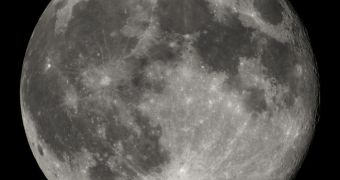According to the conclusions of a new scientific report, it would appear that the interior of the Moon is equally as wet as Earth's. The discovery comes on the heels of another shocking finding, which indicates that the surface of our natural satellite may be as wet as the Sahara Desert.
While this may not seem like a lot at first, at least it implies that the lunar surface is not bone-dry, and that some water can still be found at that location. But finding out that the Moon's core is similar to our planet's own is a remarkable discovery.
Investigators now suggest that the humidity they see in Earth's upper mantle is of the exact same kind that they can see at the lunar core. The upper mantle is a region of fluid molten rocks, on which the tectonic plates supporting the oceanic and continental crusts are floating.
The crust is several miles thick, but its exact spread depends on its type. Continental crust plates are significantly thicker than oceanic ones, which don't need to support that much weight.
According to investigators, the new discoveries were made after they analyzed samples of lunar magma, that had been thrown to the Moon's surface by powerful volcanic eruptions that took place in the past, Space reports.
At the object's south pole, experts managed to identify water-ice reserves numbering in the billions of gallons. These deposits endure in permanently-shadowed craters, that haven't seen the light of the Sun for millions of years.
“You really would not expect, based on what we know about [existing models], to have any water present in the Moon at all,” explains expert Erik Hauri, who was the lead author of the new study.
“The fact that these [samples] have terrestrial levels of water is really a stunner,” adds the expert, who holds an appointment at the Carnegie Institution of Washington (CIW). He and his team analyzed Moon rocks in order to come to this conclusion.
The samples were collected from the Moon by Apollo Program astronauts in 1972, during the Apollo 17 flight. In geological terms, these structures are called melt inclusions.
“These samples provide the best window we have on the amount of water in the interior of the Moon,” adds Case Western Reserve University expert and study coauthor James Van Orman. The study is detailed in the May 26 issue of the top journal Science.
Analyzing deposits formed by explosive volcanism is turning out to be one of the most useful, yet little-explored scientific methods of gaining more insight into a cosmic object's history and properties.
“We've shown in our study that this is really the best way to get at the water content of a planetary interior, and be able to tell whether a planet is actually capable of creating an ocean or an atmosphere through volcanic processes,” Hauri argues.
“We would really advocate pretty strongly that any sample-return mission should focus on this type of material,” he concludes.

 14 DAY TRIAL //
14 DAY TRIAL //